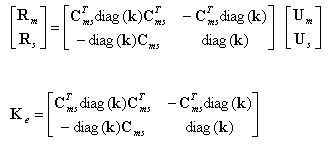The Rlink element, which is automatically inserted into the place of a defined rigid link during calculations, provides the ability to use a concentrated mass matrix for dynamic problems.

The stiffness matrix for the element presented in the drawing above is as follows:

Cms= matrix of transformation of displacements from the master node to the slave node ![]()
Cms trans= matrix of transformation of reactions from the slave node to the master node ![]()
Us= displacement vector for the slave node
Um= displacement vector for the master node
Rs= reaction vector for the slave node
Rm= reaction vector for the master node
diag(k)= diagonal matrix created from vector k, which is a vector of stiffnesses ascribed to individual degrees of freedom.
Advantages:
The Rlink element is treated as a regular finite element allowing for:
- Concentrated mass matrix for dynamic problems
- Releases in a slave node
- Compatible nodes in a slave node
- Rotated support in the master node.
Disadvantages:
There is an increased number of degrees of freedom in a system. Those in standard rigid links of a slave node are inherited from the master node. Degrees of freedom in an Rlink element of the master node and the slave node are treated separately.
The poorer conditioning of the stiffness matrix may have an adverse effect on the convergence of the iterative solvers.